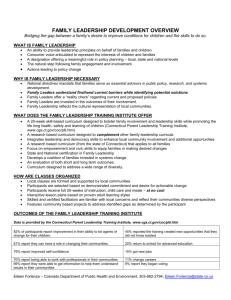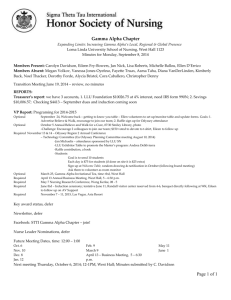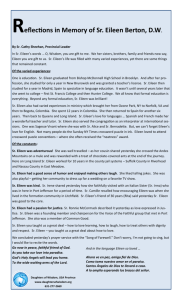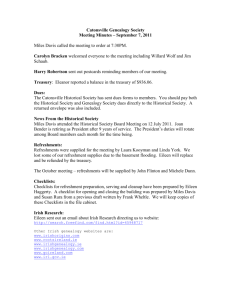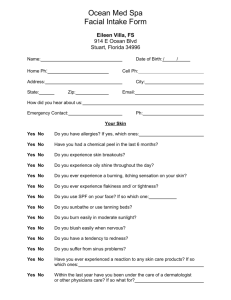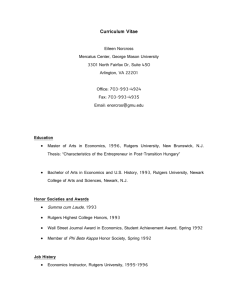No printed word nor spoken plea
advertisement
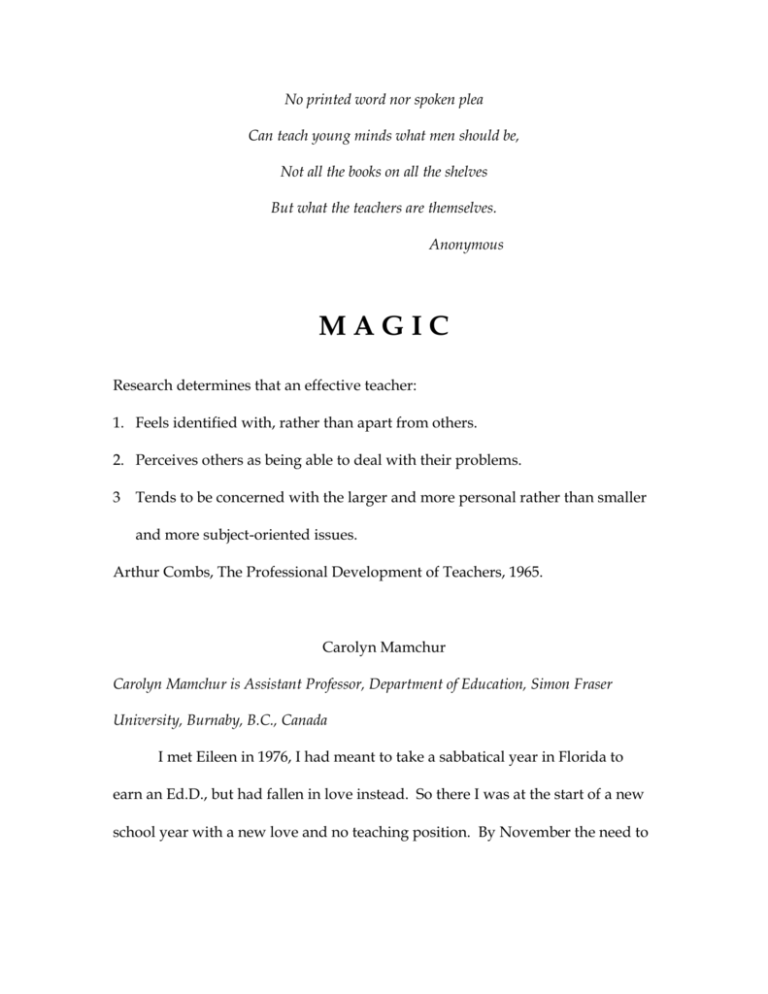
No printed word nor spoken plea Can teach young minds what men should be, Not all the books on all the shelves But what the teachers are themselves. Anonymous MAGIC Research determines that an effective teacher: 1. Feels identified with, rather than apart from others. 2. Perceives others as being able to deal with their problems. 3 Tends to be concerned with the larger and more personal rather than smaller and more subject-oriented issues. Arthur Combs, The Professional Development of Teachers, 1965. Carolyn Mamchur Carolyn Mamchur is Assistant Professor, Department of Education, Simon Fraser University, Burnaby, B.C., Canada I met Eileen in 1976, I had meant to take a sabbatical year in Florida to earn an Ed.D., but had fallen in love instead. So there I was at the start of a new school year with a new love and no teaching position. By November the need to 2 be in a classroom pushed me, a little reluctantly, a lot excitedly, through the doors of the local School for Retarded Children. “Good morning. I’d like to do some volunteer work. I’m a teacher. I’ve only taught high school English. But maybe you have something….” Life skills. What the hell are they? Just what skills would I pass on in the name of success? happiness? independence? I was given a lesson in behavior modification and told that although cleanliness may no longer hold its place next to godliness, it would sure be nice if the girls acquired some basic skills in good grooming. That first morning, in preparation for classes, I carefully braided my hair, weaving a bright scarlet ribbon into the strands. My nails matched my lipstick. I chose to wear a white dress splashed with pink roses. It was a simple dress of easy-to-sew cotton. I hoped it was soft and feminine and appealing. During the lunch hour I proceeded to cut out an apron of matching material. The next day I sewed a hem. Finally, on went a piece of lace and it was ready to wear during “break time” when we toasted tea cakes and made rich chocolate milks and sipped them in the finest china I could find. In fact, it was an antique set my great grandmother had brought from Germany. We used linen napkins and silver spoons. Each day I brought fresh flowers for our table. I didn’t talk much about washing hair or feeling good about oneself. I didn’t show films on it or give sewing lessons. But suddenly the girls were braiding one another’s hair. And when it didn’t shine, they were washing and rinsing and conditioning. 3 Heirloom dishes are always carefully washed. Linen napkins deserve ironing and folding. Silver spoons and teapots warrant a shine, a polish, a making of funny faces into. Pieces of ribbon and lace and soft cotton appeared and sewing machines started whirring. It was amongst those sporadically running, racing, stopping, starting again machines that I came to know Eileen, came to recognize the large soft body moving noisily between the girls, the rich, soothing voice encouraging, laughing, admiring. As is the case with so many handicapped children, Eileen suffered from many ailments, including diabetes and arthritis. Despite the fact that swelling and pain demanded daily visits from the nurse who applied ice and weights to Eileen’s legs and despite the fact her fingers curled in painful distortions, Eileen was never deterred from helping a shaky friend thread a needle, or organizing the younger children into a game in the playground. I saw Eileen suffer more than any child I’d ever known, but I never heard her complain, never once, and I often heard her laugh. But even more I heard her assure, encourage, assist and sometimes insist. I saw her believe in herself and in those around her. One afternoon, in desperation and fatigue, the nurse complained to Eileen, “But Eileen, why ever didn’t you tell us about the pain in your legs before it got so bad? We could have helped you so much more if you had. Next time, for heaven’s sake tell somebody.” 4 Eileen’s eyes filled with tears. The nurse returned to her V.O.N. van. Eileen and I talked. “She didn’t mean to make you sad, Eileen. She just hates to see you hurt so much. It’s easier to help someone when they first get sick. Telling a nurse or someone who can help is a good thing to do. No one gets angry when you’re sick. Everyone just wants to help.” My meaningless words ran on. Eileen listened patiently. When I finished she looked at me quietly. Her voice shook a little as she spoke. “But I was at home.” “Home?” My voice was full of surprise. “But surely you could have told your mother?” “No.” Quietly. “No?” Still not understanding. “No.” A pause. “She was too sad already.” I rubbed Eileen’s legs for an extra long time that day. It felt good to touch her. We didn’t say much. We just looked at each other and smiled a lot. “. . . what I was witnessing, indeed, what we were doing, was organic teaching I guess we became a team. It was my first team-teaching experience. It was my best. Together, with Eileen modeling, encouraging, expecting, understanding much more than I, we moved through what became a rather mobile life skills 5 program. Reading lessons from basal texts were never given. But recipes and instructions on sewing patters were carefully followed. Safety rules never appeared in bright posters on the walls. We had no time to make posters. We were busy catching buses, walking to stores, shopping for chocolate and croissants and matching ribbons and laces. Math was never really part of any formal lesson, but when we sold homemade popcorn balls and handsewn aprons to earn extra shopping money, we sure checked out prices and counted change. I saw Eileen help an eight-year-old count her money four times before she was content to leave a frowning clerk who somehow felt compelled to endure the painstaking procedure. His annoyance didn’t rattle Eileen a bit; it was Jody’s uncertainty at having the right change that concerned her. And with that she carefully, patiently dealt. That day, as I watched Eileen direct Jody in the counting of change, it occurred to me that what I was witnessing, indeed, what we were doing, was organic teaching. I hurried home, reread Teacher and recharged my teaching batteries. Classical music became a part of our tea-time pleasure. It wasn’t long before we were able to delight one another, and quite frankly, ourselves, with our own music. I played the instrument of my childhood, the piano. The rest of the girls improvised in glorious harmony and mood on Orff instruments. 6 And with music, naturally, came dance. We danced, we read the life story of Isadora and saw the movie with Vanessa Redgrave, I guess we all became more beautiful that year. Finally, sadly and with happiness, the year ended and my not so new love and I did move to Florida in order for me to continue with that promised learning. Each Christmas I sent Eileen a small present. Each Christmas I missed her more. Eileen, the snow the smell of pine, bits of ribbon, Eileen. Each Christmas. In 1979 the present was returned to me. With it came a note from Eileen’s mother. “I’m sorry. Thank you for sending this, but Eileen passed away this winter.” I wrote back. I think I talked about sorrow and loss. Somewhere I mentioned gratitude. Did I know enough to really tell her of her gift to the world, and to me. Somehow did that woman come to understand the inspiration, the magic that was and is her daughter? 7 Children have two visions, the inner and the outer. Of the two the inner vision is brighter. (Ashton-Warner, 1963) References Ashton-Warner, Sylvia. Teacher. New York: Simon & Schuster, 1963. Combs, Arthur. The Professional Development of Teachers: A Perceptual View of Teacher Preparation. Boston: Allyn & Bacon, 1965.
